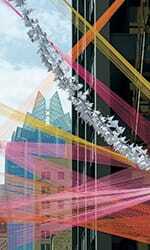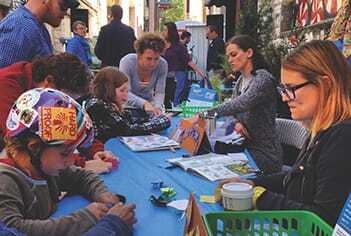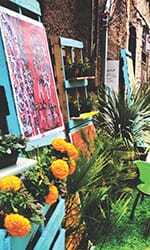In Austin, they’re proving that alleyways can be animated—and delightful.
One of the joys of traveling abroad is getting swept away in a labyrinth of side streets and alleys, becoming immersed in an engaging milieu of cafés, shops, and hidden treasures. Linear spaces leading to destinations like Campo de’ Fiori in Rome and the Nanluoguxiang, a hutong in Beijing, buzz with activity day and night as they present opportunities to explore a veritable warren of inviting promenades and nearby pathways. Pedestrian-oriented streets give way to intimate, meandering alleyways often filled with bistros, people, and architectural wonders, providing layers of interest to the urban fabric while capitalizing on limited space. Similarly, as Jane Jacobs famously noted decades ago, an active public realm means more “eyes on the street,” and thus a safer environment.
In the United States, alleys are typically far less inviting and most often viewed simply as functional spaces that accommodate requisite activities like deliveries, loading, and trash pickup. Rarely are they considered places where people would congregate or linger. But what if alleys could serve more than a mere functional and connective role in the urban environment and provide an inviting setting for events?
This question was posed by Heather Way, vice chair of the Austin Downtown Commission in Austin, Texas. Inspired by a recent trip to Spain and France, she organized a multidisciplinary workshop in November 2012 to explore activating Austin’s downtown alleys.
“We wanted to showcase how our downtown alleys can help fill our need for more vibrant public spaces, which is a priority in Austin’s new downtown plan,” Way says. The workshop united a dozen stakeholders from a variety of disciplines, including members of Art Alliance Austin, Austin Downtown Commission leaders, city public works officials, council aides, and students from the University of Texas Center for Sustainable Development.
This team transformed a downtown alley through an active public exhibition called 20ft WIDE that took place in Austin during April. The exhibition’s name refers to the 20-foot (6.1 m) standard width of downtown Austin alleys as laid out in the original 1839 city map plotted by Edwin Waller, the city’s first mayor. After scouting several alleys as candidates, the team settled on Alley Number 111, located on Ninth Street between Congress Avenue and Brazos Street.
This particular alley, long and linear in form and defined by historic limestone walls and suspended fire escapes, was next to a vacant building, which provided valuable space for staging of events, and provided access to electricity and water from adjacent property owners. About half the alley was activated through the inclusion of art, seating, plants, and other elements, while the other half accommodated necessary functions like trash pickup and parcel loading and unloading.
Enlisted by curatorial lead Art Alliance Austin, architects Dan Cheetham of architecture firm Fyoog and Michelle Tarsney—along with Creative Action, a local nonprofit group that promotes childhood development and education through art-based programs—worked collaboratively with me and Nicole Warns, my colleague at TBG Partners, on the space’s design. The intent was to showcase the potential for a ubiquitous yet overlooked public space in the urban environment through a pop-up transformation that would be multipurpose, compelling, and temporary. The project offered a showcase of the alley’s importance and utilitarian beauty—and an opportunity to provide a multifaceted experience in one of the most neglected public environments in the cityscape.
To create a human scale and interest at multiple levels, we viewed the alley from varying perspectives. The upper levels were activated through the installation of tautly stretched, interweaving twine in vibrant hues of orange, pink, and yellow. The twine formation was accented by an assemblage of paper origami peace cranes—created by local children at an arts festival the previous weekend—attached to a fire escape stair and ascending skyward through the twine in a natural flight pattern. At ground level, elements associated with typical alley functions were employed, including stacked pallets, burlap sacks stuffed with donated clothes, polystyrene shipping foam, and donated plant materials.
After weeks of planning and set-up, the alley was opened to the public on a Wednesday in mid-April. The opening night introduced the concept and the transformed space to the public as visitors socialized, viewed art, and heard a performance by Convergence, an Austin-based music ensemble dedicated to inter-arts collaboration.
On the second night, the alley was the venue for a PechaKucha session—a fast-moving presentation in which people show 20 images for 20 seconds each. About 300 people attended, which made it easily the largest gathering ever in Alley Number 111.
The following morning, the alley featured a breakfast attended by downtown workers and commuters. In the evening, committee members and volunteers attended a formal candlelight dinner in the alley. Saturday was Alley Kids Family Day, during which the space was adapted into an artist-driven playground for kids and adults. Children played and enjoyed storytelling, music, arts and crafts, food trucks, and acrobatics. Sunday was an open day for visitors to experience the alley as a work of art one final time.
“The public exhibition’s curatorial intent was to connect to the dynamic past, present, and future roles of the urban alley system, both physically through the installations and through active participation in a diverse, multigenerational program,” says Meredith Powell, executive director of Art Alliance Austin. “We believe artists play a critical role in creating more adaptable, resilient, contemporary cities and communities that are engaged in public life.”
The project offered valuable takeaways, particularly in that it showcased the multipurpose functionality of the space. “This project changed people’s perception by fostering a public conversation about the positive roles of our downtown alleys and inspiring the public imagination about the different ways in which alleys can become these vibrant, people-oriented spaces,” Way says. “Our alley team is very excited about the possibilities for replicating this project in other parts of downtown Austin and other cities.”






